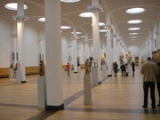
Gemäldegalerie, Berlin
Encyclopedia
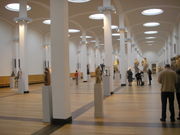 |
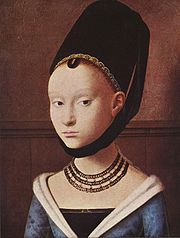 |
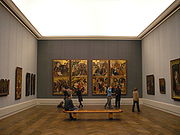 |
The Gemäldegalerie is an art museum in Berlin
Berlin
Berlin is the capital city of Germany and is one of the 16 states of Germany. With a population of 3.45 million people, Berlin is Germany's largest city. It is the second most populous city proper and the seventh most populous urban area in the European Union...
, Germany. It holds one of the world's leading collections of European art from the 13th to the 18th centuries. It is located on Kulturforum
Kulturforum
The Kulturforum is a collection of cultural buildings in Berlin, Germany. It was built up in the 1950s and 60s at the edge of West Berlin, after most of the once unified city's cultural assets had been lost behind the Berlin Wall...
west of Potsdamer Platz
Potsdamer Platz
Potsdamer Platz is an important public square and traffic intersection in the centre of Berlin, Germany, lying about one kilometre south of the Brandenburg Gate and the Reichstag , and close to the southeast corner of the Tiergarten park...
. Its collection includes masterpieces from such artists as Albrecht Dürer
Albrecht Dürer
Albrecht Dürer was a German painter, printmaker, engraver, mathematician, and theorist from Nuremberg. His prints established his reputation across Europe when he was still in his twenties, and he has been conventionally regarded as the greatest artist of the Northern Renaissance ever since...
, Lucas Cranach
Lucas Cranach the Elder
Lucas Cranach the Elder , was a German Renaissance painter and printmaker in woodcut and engraving...
, Raphael
Raphael
Raffaello Sanzio da Urbino , better known simply as Raphael, was an Italian painter and architect of the High Renaissance. His work is admired for its clarity of form and ease of composition and for its visual achievement of the Neoplatonic ideal of human grandeur...
, Titian
Titian
Tiziano Vecelli or Tiziano Vecellio Tiziano Vecelli or Tiziano Vecellio Tiziano Vecelli or Tiziano Vecellio (c. 1488/1490 – 27 August 1576 better known as Titian was an Italian painter, the most important member of the 16th-century Venetian school. He was born in Pieve di Cadore, near...
, Caravaggio
Caravaggio
Michelangelo Merisi da Caravaggio was an Italian artist active in Rome, Naples, Malta, and Sicily between 1593 and 1610. His paintings, which combine a realistic observation of the human state, both physical and emotional, with a dramatic use of lighting, had a formative influence on the Baroque...
, Peter Paul Rubens, Rembrandt and Johannes Vermeer
Johannes Vermeer
Johannes, Jan or Johan Vermeer was a Dutch painter who specialized in exquisite, domestic interior scenes of middle class life. Vermeer was a moderately successful provincial genre painter in his lifetime...
. It was first opened in 1830, and was rebuilt in 1998.
History
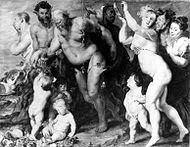
Lustgarten
The Lustgarten is a park on Museum Island in central Berlin, near the site of the former Berliner Stadtschloss of which it was originally a part...
on Unter den Linden
Unter den Linden
Unter den Linden is a boulevard in the Mitte district of Berlin, the capital of Germany. It is named for its linden trees that line the grassed pedestrian mall between two carriageways....
, a famous Berlin street. The collection began largely with the collection of Frederick William I, known as the Great Elector and Frederick the Great. It was along the centuries enlarged not only through acquisitions but also by means of war booty and contains many objects looted
Looting
Looting —also referred to as sacking, plundering, despoiling, despoliation, and pillaging—is the indiscriminate taking of goods by force as part of a military or political victory, or during a catastrophe, such as during war, natural disaster, or rioting...
from Poland
Poland
Poland , officially the Republic of Poland , is a country in Central Europe bordered by Germany to the west; the Czech Republic and Slovakia to the south; Ukraine, Belarus and Lithuania to the east; and the Baltic Sea and Kaliningrad Oblast, a Russian exclave, to the north...
. These were paintings obtained from the royal collections in 1656 (Polish Vasas
House of Vasa
The House of Vasa was the Royal House of Sweden 1523-1654 and of Poland 1587-1668. It originated from a noble family in Uppland of which several members had high offices during the 15th century....
collection), in 1740 (Silesia
Silesia
Silesia is a historical region of Central Europe located mostly in Poland, with smaller parts also in the Czech Republic, and Germany.Silesia is rich in mineral and natural resources, and includes several important industrial areas. Silesia's largest city and historical capital is Wrocław...
n collection of John III Sobieski
John III Sobieski
John III Sobieski was one of the most notable monarchs of the Polish–Lithuanian Commonwealth, from 1674 until his death King of Poland and Grand Duke of Lithuania. Sobieski's 22-year-reign was marked by a period of the Commonwealth's stabilization, much needed after the turmoil of the Deluge and...
) and in the beginning of the 19th century (Stanisław Augustus collection), as well as from many confiscations after the Partitions of Poland
Partitions of Poland
The Partitions of Poland or Partitions of the Polish–Lithuanian Commonwealth took place in the second half of the 18th century and ended the existence of the Polish–Lithuanian Commonwealth, resulting in the elimination of sovereign Poland for 123 years...
.
The gallery's first director was Gustav Friedrich Waagen
Gustav Friedrich Waagen
Gustav Friedrich Waagen was a German art historian.Waagen was born in Hamburg, the son of a painter and nephew of the poet Ludwig Tieck. Having passed through the college of Hirschberg, he volunteered for service in the Napoleonic campaign of 1813-1814, and on his return attended the lectures at...
. Berlin's premier name in museum direction, Wilhelm von Bode
Wilhelm von Bode
Wilhelm von Bode was a German art historian and curator. Born Arnold William Bode in Calvörde, he was ennobled in 1913...
, served the gallery from 1890 to 1929. His leadership marked the rise of the Gemäldegalerie to international prominence.
A nucleus for the collection was formed by the purchase in 1821 of the collection formed in Berlin by the English merchant Edward Solly
Edward Solly
Edward Walter Solly was an English cricketer who played eight first-class games for Worcestershire as a professional between 1903 and 1907....
. In 1904 the Gemäldegalerie was largely a collection of Renaissance art when it moved to the newly built Kaiser Friedrich Museum, later known as the Bode Museum
Bode Museum
The Bode Museum is one of the group of museums on the Museum Island in Berlin, Germany; it is a historically preserved building. The museum was designed by architect Ernst von Ihne and completed in 1904...
. The museum was badly damaged during World War II
World War II
World War II, or the Second World War , was a global conflict lasting from 1939 to 1945, involving most of the world's nations—including all of the great powers—eventually forming two opposing military alliances: the Allies and the Axis...
, however most of the collection survived the war in shelters across Germany. At the end of World War II however, 400 works that were regarded as too large to take to the remoter hiding places were destroyed in a fire of a Flak tower that served as a bomb shelter. Many important altarpieces and other large works were lost, and the collection remains short of very large works compared to the other major European collections. Furthermore, several hundred paintings looted by Russian as well as American soldiers or confiscated and never returned by the Red Army. The rest of the collection was divided between East Berlin (mostly at the Bode Museum on Museumsinsel) and West Berlin in Berlin-Dahlem.
In June 2006 a small painting by Alessandro Allori
Alessandro Allori
Alessandro di Cristofano di Lorenzo del Bronzino Allori was an Italian portrait painter of the late Mannerist Florentine school....
, missing since 1944, was returned by the British journalist Charles Wheeler
Charles Wheeler (journalist)
Sir Charles Cornelius Wheeler CMG was a British journalist and broadcaster. Having joined the BBC in 1947, he became the corporation's longest serving foreign correspondent, serving in the role until his death...
, who had picked it up at the end of the war in Berlin.
The collection
The Gemäldegalerie prides itself on its scientific methodology in collecting and displaying art. Each room can be taken in as a single statement about one to five artists in a certain period or following a certain style. The German collection is the finest and most comprehensive in the world, rivalled only by Vienna and Munich, and the Early Netherlandish and Italian collections also exceptionally comprehensive. The holdings of Spanish, French and British art are much smaller. Especially notable rooms include the octagonal Rembrandt room and a room containing five different MadonnasMadonna (art)
Images of the Madonna and the Madonna and Child or Virgin and Child are pictorial or sculptured representations of Mary, Mother of Jesus, either alone, or more frequently, with the infant Jesus. These images are central icons of Roman Catholicism and Eastern Orthodox Christianity where Mary remains...
by Raphael
Raphael
Raffaello Sanzio da Urbino , better known simply as Raphael, was an Italian painter and architect of the High Renaissance. His work is admired for its clarity of form and ease of composition and for its visual achievement of the Neoplatonic ideal of human grandeur...
.

The Wine Glass
The Wine Glass is a painting by the Dutch artist Johannes Vermeer that portrays a seated woman and a standing man drinking in an interior setting. The painting is in the Gemäldegalerie, Berlin. The work is, in many aspects, typical of the genre painting of the Delft School developed by Pieter de...
and Woman with a Pearl Necklace
Woman with a Pearl Necklace
Woman with a Pearl Necklace is an oil painting by Jan Vermeer, produced between 1662 and 1665. It is now in the Gemäldegalerie Berlin....
.
Other notable experiences include Flemish
Flemish painting
Flemish painting flourished from the early 15th century until the 17th century. Flanders delivered the leading painters in Northern Europe and attracted many promising young painters from neighbouring countries. These painters were invited to work at foreign courts and had a Europe-wide influence...
moralistic paintings which stretch across the north side of the museum, showing an interplay between the religious motives of the artists' patrons and the often sensual inspirations of the artists. In the Renaissance
Renaissance
The Renaissance was a cultural movement that spanned roughly the 14th to the 17th century, beginning in Italy in the Late Middle Ages and later spreading to the rest of Europe. The term is also used more loosely to refer to the historical era, but since the changes of the Renaissance were not...
section, for example, Caravaggio
Caravaggio
Michelangelo Merisi da Caravaggio was an Italian artist active in Rome, Naples, Malta, and Sicily between 1593 and 1610. His paintings, which combine a realistic observation of the human state, both physical and emotional, with a dramatic use of lighting, had a formative influence on the Baroque...
's Amor Victorious is displayed alongside Giovanni Baglione
Giovanni Baglione
Giovanni Baglione was an Italian Late Mannerist and Early Baroque painter and art historian. He is best remembered for his acrimonious involvement with the artist Caravaggio and his writings concerning the other Roman artists of his time.-Early life:A pupil of Francesco Morelli, he worked mainly...
's Sacred Love Versus Profane Love. The two paintings are historically connected; after hearing of the scandalous portrayal of the theme "love conquers all" in Caravaggio's work, a Roman bishop commissioned Baglionne's reply, which mimics Carvaggio's style, including the features of Amor.
The galleries
The main galleries are arranged in a horseshoe around a very long central space, containing only a few sculptures, described by the museum as a "meditation hall", but mainly filled by school parties eating. However it means it is much easier to navigate the collection than in most large galleries.The collection is arranged more or less chronologically starting from the entrance and moving toward the farthest room; however there are many doors back to the long central space, so it is straighforward to reach any other room at any point. The visitor chooses between southern, mainly Italian, art to the left, and German and Flemish art to the right. Completing the circuit takes the visitor first forward, then backward, in time. The numbering system starting on the north side of the museum covers mostly Northern European art, then British art. A visitor following along the southern side will go through mostly Italian and Southern European art. The main floor galleries contain some 1200 works, with around 400 more in several rooms off a corridor downstairs, which are also open to visitors.
Architecture and layout
The gallery sits in the southwest corner of the KulturforumKulturforum
The Kulturforum is a collection of cultural buildings in Berlin, Germany. It was built up in the 1950s and 60s at the edge of West Berlin, after most of the once unified city's cultural assets had been lost behind the Berlin Wall...
, a modern-styled answer to East Berlin
East Berlin
East Berlin was the name given to the eastern part of Berlin between 1949 and 1990. It consisted of the Soviet sector of Berlin that was established in 1945. The American, British and French sectors became West Berlin, a part strongly associated with West Germany but a free city...
's Museumsinsel (Museum Island) which was inaccessible to West Berlin
West Berlin
West Berlin was a political exclave that existed between 1949 and 1990. It comprised the western regions of Berlin, which were bordered by East Berlin and parts of East Germany. West Berlin consisted of the American, British, and French occupation sectors, which had been established in 1945...
ers when the city was divided by the Berlin Wall
Berlin Wall
The Berlin Wall was a barrier constructed by the German Democratic Republic starting on 13 August 1961, that completely cut off West Berlin from surrounding East Germany and from East Berlin...
from 1961 through 1989. The gallery was designed by Munich
Munich
Munich The city's motto is "" . Before 2006, it was "Weltstadt mit Herz" . Its native name, , is derived from the Old High German Munichen, meaning "by the monks' place". The city's name derives from the monks of the Benedictine order who founded the city; hence the monk depicted on the city's coat...
architects Heinz Hilmer and Christoph Sattler. The building consists of 72 rooms providing a two-kilometer (1.25 mi) floor. Upstairs the rooms flow around a center hall the size of a football (soccer)
Football (soccer)
Association football, more commonly known as football or soccer, is a sport played between two teams of eleven players with a spherical ball...
field; the hall sometimes displays sculpture. There are also works downstairs, a gallery devoted to frames, and a digital gallery.
External links
- Staatliche Museen zu Berlin | Gemäldegalerie
- Kaiser-Friedrich-Museums-Verein Association of the friends of the Gemäldegalerie
- www.kulturforum-berlin.com Information about all cultural institutions at the "Kulturforum" in Berlin
- Review of Gemäldegalerie

